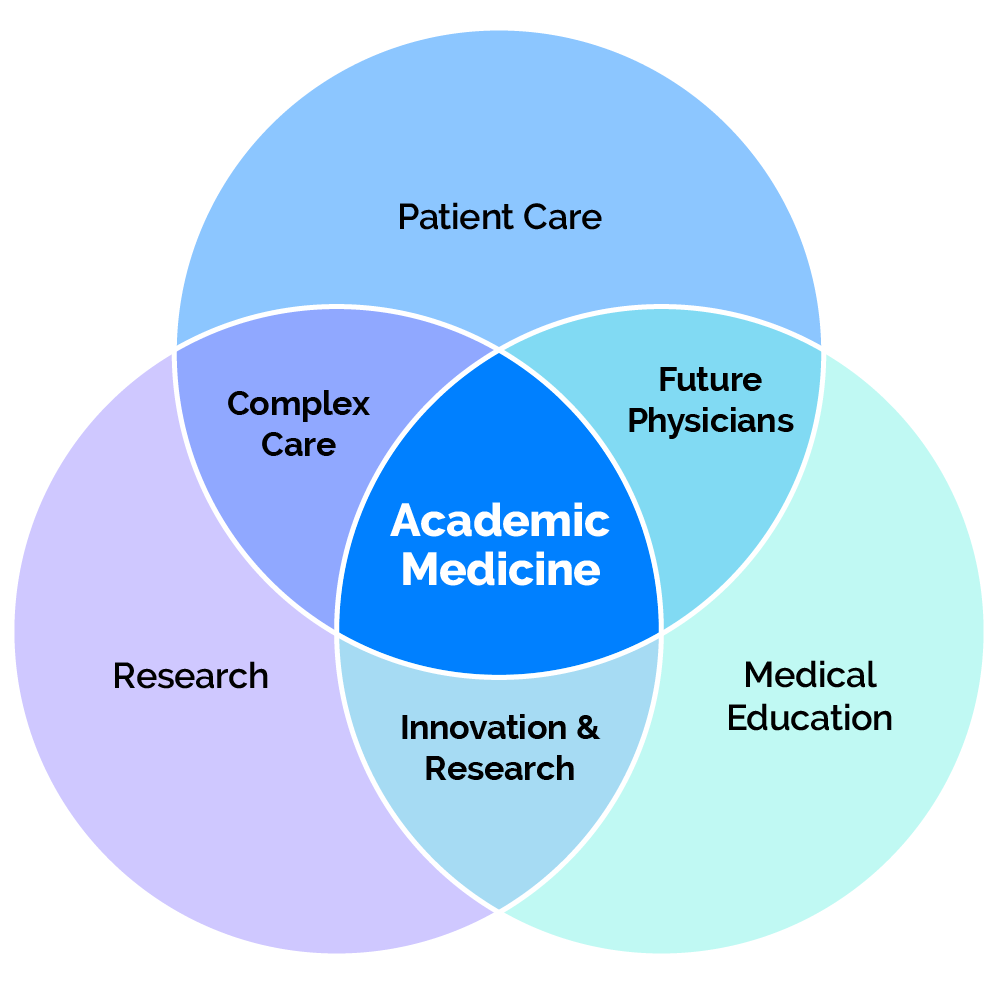What I’ve Learned Working with an Academic Medical Center
What I’ve Learned Working with an Academic Medical Center
Jordan Hirsch | Director of Training and Facilitation
April 19, 2021
I recently had the chance to run a strategic discovery for an academic medical center (AMC) that wants to revamp, redesign, and rethink its digital presence. Here’s what I’ve learned so far working with this unique type of institution.
What is an AMC?
An AMC is an organization where research, education, and clinical care are all combined under one roof; three missions operating in service of one mission. These centers provide medical care (general and highly specialized); educate future physicians, scientists, and other medical professionals; and conduct basic and advanced research, leading to cutting-edge innovations and therapies. According to a recent study published in the Journal of the American Medical Association (JAMA), patients treated at a teaching hospital had a 20% higher survival rate than patients treated at a non-teaching hospital.

Ideally, each arm of an AMC’s tripartite mission supports and supplements the others, strengthening the overall whole, providing massive benefits to patients, students, and researchers.
The Challenge
Phase2 was brought in to help a world-renowned AMC leverage its digital channels more effectively to better serve multiple audiences, increase internal efficiency, and communicate its mission and value to the world. This organization has more than 300 websites, creating a fractured user experience, damaging brand coherence, and leaving key audiences unsure of where to go to find the right information. This situation has led to instances of duplicate (and sometimes inconsistent) content, and massive internal overheard managing the center’s digital presence.
Our Approach
Phase2’s strategic discovery process allowed us to dive deep into this AMC and really understand their goals, needs, and success metrics. We interviewed more than 50 stakeholders from across the organization, fielded stakeholder surveys, led several virtual workshops, and conducted audits and analyses of their sites, content, design, user experience, data, and brand. We reviewed and analyzed digital peers — both direct competitors in the healthcare space, as well as other high-profile brands whose digital experiences set expectations for users across industries. We also interviewed over more than 20 users as part of our overall user research efforts.
What We Delivered
At the end of our strategic discovery phase, we delivered a strategic insights and recommendations report. Here are the key elements:
- Goals & Audiences: We helped the center state a clear and compelling goal for its web presence that ladders up to and supports the mission, values, and strategic plans. This was the most foundational piece of our work; every other finding and recommendation is in support of this overarching goal. We also helped clarify and prioritize key audiences and goals for each major area of site content.
- Brand Clarity: It’s challenging to express the brand of an organization as complex as an AMC, with multiple internal and external areas of focus. We provided guidelines on how best to express the digital brand to provide clarity and value for the AMC and its key audiences. This work will be supported by a full content strategy and visual design treatment to bridge the gap from discovery to a fully realized website.
- A Focus on Users: We recommended a massive streamlining and simplification of the center’s websites, proposing a structure for the majority of its existing content organized by the needs of their users. Organizing both the overall information architecture and the sites themselves in this way will fulfill the goals of the center’s web presence while serving its audiences.
- A Data-Driven Approach: This AMC has a major opportunity to do more with data. In addition to recommending needed enhancements and fixes to its current data and analytics setup, we recommended a set of KPIs that measure progress against digital strategy and form the beginning of an overall strategic measurement model.
- Change Management: By nature, AMCs are often more collaborative and consensus-based cultures as opposed to following top-down command-and-control methods. We encouraged our client to lean into this aspect of their culture and begin enrolling stakeholders early. We also identified ways our product planning and development milestones and deliverables can support their change management plans.
What I Learned
AMCs are complex beasts, comprising diverse sets of stakeholders serving multiple missions and audiences under one roof. This makes AMCs fascinating — and challenging — to support with a cohesive digital strategy. The collaborative nature of these organizations means that stakeholder enrollment and change management efforts are paramount to the success of any digital transformation. And their missions, while separate, are truly interrelated, each supporting and intertwined with the others.
Telling the story of an AMC is a daunting task, but these centers stand to reap huge rewards from rethinking and investing in digital transformation and well-planned digital strategies. I’m proud that Phase2’s digital strategy work is helping to support these vital organizations.
I hope you enjoyed reading the Phase2 blog! Please subscribe below for regular updates and industry insights.

